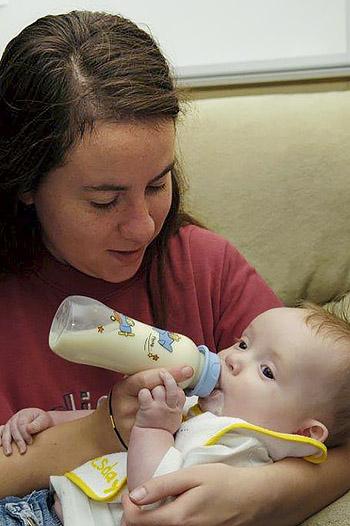Feeding baby
Duration/age

As you feed your baby it is a wonderful time to talk to them. You can do it when you snuggle up close to feed them or when they are sitting in their highchair.
Talk to your baby about how much, how fast and what they are eating. As you feed your baby describe the colour and the texture of the food. You can also talk about things that are happening around you or that you can see.
You’re eating mashed peas and spinach today. That is very green. It’s a little bit lumpy because I mashed it with a fork. After you have finished the peas and spinach you can try the smooth, slippery custard.
I think you are very hungry today. You are drinking your bottle of milk very quickly.
Try changing where you sit to feed your baby. This will give you different things to see, feel and talk about. If you sit outside you can talk about the warmth of the sun or a cool breeze that might blow across your baby’s skin. Sometimes there could be different noises to hear and scents or smells to describe.
Materials you will need
- Food
- Your baby
- Bottle
Skills this activity improves
Why does this matter?
Listening to, identifying and responding to talking and sounds in the environment helps your baby to develop listening and language skills.
When you sing or share traditional stories and language from your own culture with your baby you are helping them to develop a strong cultural identity. The sharing of family stories, songs and language helps to pass on family information and traditions that often are not written down.
What does this lead to?
When children are surrounded by language, stories, songs and sounds they are beginning to make connections to the structure of language and how we communicate. The different words and language they hear forms the foundation of oral language.
As your baby listens to you they will be learning to identify where sounds are coming from and to respond to the different sounds they hear. As your baby’s hearing develops they will begin to hear different tones and pitches. Identifying different sounds, pitch and tone helps us to understand how the other person is feeling and the importance of the message.
Language to use
- Mashed, smooth, lumpy, creamy, solid, liquid
- Sun, wind, breeze, shadow, light, shade, dappled sunlight
- Bottle, spoon, bowl, cup
- Song, talk, noise, sound, hum, story
- Face, eyes, mouth, ears
Questions to use
- Can you hear the birds singing outside?
- Can you feel the sun tickling your toes?
- Can you see the wind ruffling my hair?
- How hungry are you?
- Do you want the mashed banana or the mashed sweet potato?
Useful tips
- You might also like to take a look at the activities Telling stories and Baby talk.
- Remember that your eyes and facial expressions add to the way you communicate.
- Information about hearing, sound and language development can be found in your baby's health record in the Blue Book.
- If you are concerned about your baby's hearing talk to your local doctor or Child and Family Health Services (CAFHS) worker.
- Remember to talk to your child in your home language.
More ideas
- You could read a story.
- Hum or use your voice to make different sounds and noises.
Variation by age
Birth to two year olds
- Use your hands and fingers to add actions to your songs and rhymes.
- Sing nursery rhymes.
- Change your voice to sound like different animals or people.


